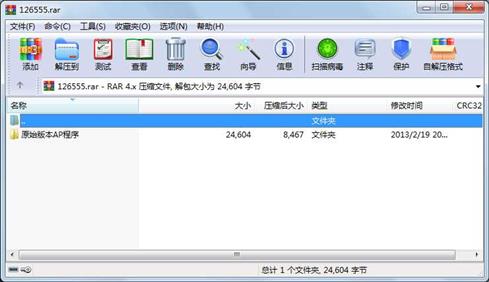资源简介
这是近邻传播聚类算法创始人Frey & Dueck在2007年Science杂志上面发表的“Clustering by Passing Messages between data points”论文里面方法的MATLAB实现程序代码,俗称AP聚类代码。里面包含两个版本:一个是普通版的,一个是稀疏版本的,下载后,先添加数据集,再调用这两个方法就行了。

代码片段和文件信息
%APCLUSTER Affinity Propagation Clustering (Frey/Dueck Science 2007)
% [idxnetsimdpsimexpref]=APCLUSTER(sp) clusters data using a set
% of real-valued pairwise data point similarities as input. Clusters
% are each represented by a cluster center data point (the “exemplar“).
% The method is iterative and searches for clusters so as to maximize
% an objective function called net similarity.
%
% For N data points there are potentially N^2-N pairwise similarities;
% this can be input as an N-by-N matrix ‘s‘ where s(ik) is the
% similarity of point i to point k (s(ik) needn抰 equal s(ki)). In
% fact only a smaller number of relevant similarities are needed; if
% only M similarity values are known (M < N^2-N) they can be input as
% an M-by-3 matrix with each row being an (ijs(ij)) triple.
%
% APCLUSTER automatically determines the number of clusters based on
% the input preference ‘p‘ a real-valued N-vector. p(i) indicates the
% preference that data point i be chosen as an exemplar. Often a good
% choice is to set all preferences to median(s); the number of clusters
% identified can be adjusted by changing this value accordingly. If ‘p‘
% is a scalar APCLUSTER assumes all preferences are that shared value.
%
% The clustering solution is returned in idx. idx(j) is the index of
% the exemplar for data point j; idx(j)==j indicates data point j
% is itself an exemplar. The sum of the similarities of the data points to
% their exemplars is returned as dpsim the sum of the preferences of
% the identified exemplars is returned in expref and the net similarity
% objective function returned is their sum i.e. netsim=dpsim+expref.
%
% [ ... ]=apcluster(sp‘NAME‘VALUE...) allows you to specify
% optional parameter name/value pairs as follows:
%
% ‘maxits‘ maximum number of iterations (default: 1000)
% ‘convits‘ if the estimated exemplars stay fixed for convits
% iterations APCLUSTER terminates early (default: 100)
% ‘dampfact‘ update equation damping level in [0.5 1). Higher
% values correspond to heavy damping which may be needed
% if oscillations occur. (default: 0.9)
% ‘plot‘ (no value needed) Plots netsim after each iteration
% ‘details‘ (no value needed) Outputs iteration-by-iteration
% details (greater memory requirements)
% ‘nonoise‘ (no value needed) APCLUSTER adds a small amount of
% noise to ‘s‘ to prevent degenerate cases; this disables that.
%
% Copyright (c) B.J. Frey & D. Dueck (2006). This software may be
% freely used and distributed for non-commercial purposes.
% (RUN APCLUSTER WITHOUT ARGUMENTS FOR DEMO CODE)
function [idxnetsimdpsimexpref]=apcluster(spvarargin);
if nargin==0 % display demo
fprintf(‘Affinity Propagation (APCLUSTER) sample/demo code\n\n‘);
fprintf(‘N=100; x=rand(N2); % Create N 2-D data points\n‘);
fprintf(‘M=N*N-N; s=zeros(M3); % Mak 属性 大小 日期 时间 名称
----------- --------- ---------- ----- ----
文件 11193 2014-01-13 15:54 原始版本AP程序\apcluster.m
文件 13411 2014-01-13 15:55 原始版本AP程序\apclusterSparse.m
目录 0 2013-02-19 20:08 原始版本AP程序
----------- --------- ---------- ----- ----
24604 3
相关资源
- MATLAB 编程 第二版 Stephen J. Chapman 著
- MATLAB Programming for Engineers 4th - Chapman
- ChinaMap.rar
- 《MATLAB编程第二版)》高清晰PDF版
- 时频分析tfsap
- 基于自适应压扩法降低OFDM系统的峰均
- ExCoVapp算法,抗噪声能力强
- introduction to audio analysis: a matlab appro
- MATLAB App Designer 教程.pdf
- Apriori算法matlab代码实现,带数据集和
- Linux2015.11V1.1思维导图周阳mmap
-
APF资料-APF、SVG simuli
nk源程使用说明 - Mathematica完美教程 - 从入门到精通
- Matlab中unwrap函数C代码实现
- Linear Algebra with Applications 9th ed - Stev
- J_Ward的空时自适应处理STAP各章对应源
- Modelling.the.Wireless.Propagation.Channel.A.s
- netapp存储MIB文件
- 用matlab写的图像分割的代码
- map match matlab
- Stephen J.Chapman《MATLAB 编程第二版》
- 近邻传播聚类算法及matlab API
- 密码学概论 原书名:Introduction to CR
- MQ之ActiveMQ_纯手敲的.mmap
- Multirate Filtering for Digital Signal Process
- 用Maple和MATLAB解决科学计算问题第三版
-
Introduction to Simuli
nk with Engineering A - SAP教程大全—SAP高手的成功秘诀!
- OPTICAL SCANNING HOLOGRAPHY WITH MATLAB
- Docker.mmap
 川公网安备 51152502000135号
川公网安备 51152502000135号
评论
共有 条评论